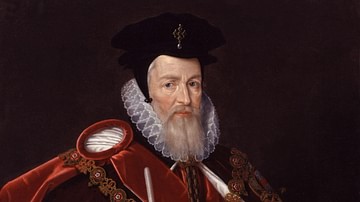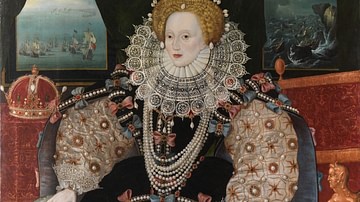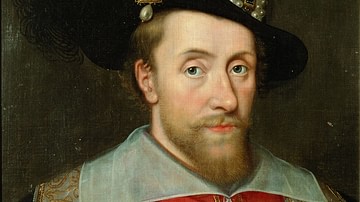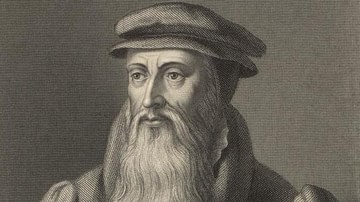
Mary, Queen of Scots was the queen of both Scotland (r. 1542-1567) and briefly, France (r. 1559-1560). Obliged to flee Scotland, the queen was imprisoned for 19 years by Elizabeth I of England (r. 1558-1603) and finally executed for treason on 8 February 1587.
Brought up in France and then marrying the heir to the French throne, Mary's world was turned upside down when her husband Francis II died in 1560 one year into his reign. The queen returned to Scotland but her Catholic views clashed with Protestants there and two more husbands and murder plots further discredited her reign. Following her forced abdication by Scottish nobles, Mary fled to England where she plotted unsuccessfully to oust her cousin Elizabeth I of England.
Family Relations
Mary Stewart was born on 8 December 1542 in Linlithgow Palace near Edinburgh. She was the daughter of King James V of Scotland (r. 1513-1542) and Mary of Guise (1515-1560). When James V, died on 14 December 1542 with no surviving male heirs, Mary, only one week old at the time, became the queen of Scotland, the first queen to rule that country in her own right. Mary was crowned nine months later on 9 September 1543 in Stirling Castle. Mary of Guise acted as the new queen's regent.
Henry VIII of England (r. 1509-1547) had briefly considered marrying his son Edward to Mary to bring the two countries closer together but the Scottish Parliament refused the proposal, and in 1544 England and Scotland were at war again. Mary did have a distant claim to the throne of England as she was the granddaughter of Margaret Tudor (1489-1541), sister of Henry VIII of England. As it was, the old ties between France and Scotland came to the fore, and in 1548 Mary was sent to be educated at the court of Henry II of France (r. 1547-1549).
Queen of France
At the French court, Mary was looked after by her mother's relations and was treated like the queen she was. Mary was given a cultured education which included learning French, Latin, Spanish, and Italian. The young queen excelled at dancing and also became a Catholic which would have serious repercussions later in her life. It was in France that Mary changed the spelling of her family name from Stewart to the French form, Stuart.

Unfortunately, Mary's marriage did not last long as Francis, never blessed with robust health, died in December 1560. Following Francis' death and her mother's in June of the same year, Mary, then still only 18, decided to return to Scotland where she would continue to press her claim for the English throne. There was further friction between the two cousin-queens as Elizabeth had been outraged by the quartering of the royal arms business and she refused to guarantee Mary safe passage to her homeland. On her side, Mary would not recognise the 1560 Treaty of Edinburgh which had officially accepted Elizabeth's right to be the queen of England. Finally, Elizabeth refused to acknowledge Mary as her heir.
Return to Scotland
Catholic Mary was not welcomed in Scotland where the barons controlled government but were themselves still divided into two camps: Catholic and Protestant. The Protestants were winning the battle for Scots minds as Scotland was undergoing a sea-change in religion through the efforts of such figures as the Calvinist minister John Knox (c. 1514-1572). Knox was an influential figure who founded the Presbyterian Church of Scotland and his views that a woman should not rule, especially one with the 'wrong' religion, were adopted by many others.

The queen made an attempt to reconcile the religious divide in her country by forbidding the holding of the mass in public (she herself attended a private mass). Mary also recognised the Reformed Church. Still, suspicions remained and were exacerbated when Mary married her cousin Henry Stewart, Lord Darnley (1545-1567), a Protestant who now favoured the Catholic mass, on 29 July 1565. From here on, things started to turn sour for the queen. First, Darnley led a group of nobles who murdered Mary's private secretary, the Italian David Rizzio (aka Riccio) on 9 March 1566. Rizzio's 'crimes' were to have been Catholic and suspected of being rather too friendly with the queen, which piqued Darnley's jealousy. The Italian was dragged from the queen's presence and knifed 56 times in an adjoining chamber.
The queen's private life then entered a new disastrous phase. Darnley himself was murdered on 10 February 1567, possibly with Mary's knowledge as the queen had not forgiven him for Rizzio's murder. The queen had had a son with Darnley, James Stuart, born on 19 June 1566 in Edinburgh Castle. As Elizabeth I still had not married or had children, James was now heir to the kingdoms of both Scotland and England.
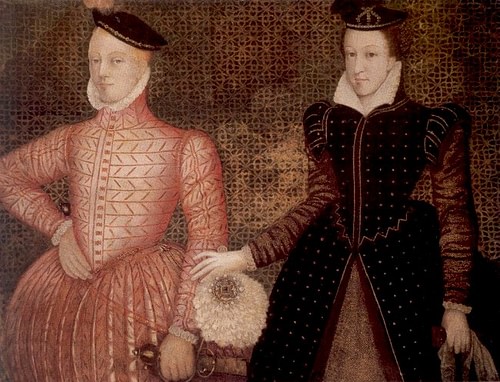
Mary was formally obliged to abdicate on 24 July 1567 in favour of her son who became James VI of Scotland (r. 1567-1625). James was barely one year old and so, given a Protestant education, he could be easily manipulated by the barons who ruled in his name. Bothwell, meanwhile, fled to Orkney, the seat of his dukedom, and from there to Norway but died in madness and obscurity in a Danish dungeon in 1578.
Escape to England
Fearing for her safety as the civil war raged on, Mary fled Scotland in May 1568 and sought sanctuary with her cousin Elizabeth in England. Mary's first attempt to escape Loch Leven Castle had involved her dressing as a washerwoman but she was given away by her aristocratic hands. A second attempt involving a rowing boat was successful. Not quite giving up on her kingdom, the queen made one more attempt to get back her throne by joining forces with supportive clans (the Campbells, Gordons, and Hamiltons). The regent, James Stewart, the Earl of Moray (l. 1531-1570) defeated this force at the battle of Langside (13 May 1568), and Mary fled south of the border.

Even in confinement, Mary was a danger to Elizabeth. The former Scottish queen had become the figurehead for Catholic-inspired plots to remove Elizabeth from her throne. In 1569 there was a rebellion in the north of England stirred up by the earls of Northumberland and Westmorland, both staunch Catholics. The plotters took Durham and hoped to have Mary become queen and then marry Thomas Howard, the Duke of Norfolk. Elizabeth responded emphatically by sending an army led by the Earl of Sussex which caused the rebel leaders to flee in panic; 900 of the rebels were rounded up and hanged. In 1570 the Pope excommunicated Elizabeth for heresy following her religious reforms (the Elizabethan Religious Settlement). As a consequence of the excommunication, all Catholics were now released from any allegiance to their queen.
Next came the 1571 Ridolfi plot (after the Florentine banker Roberto di Ridolfi). The conspiratorial Duke of Norfolk, who had been released from confinement after the 1569 failed coup, now plotted with Spain to mount an invasion of England and crown Mary queen. Norfolk was not second time lucky as the treachery was discovered when coded letters were deciphered. Norfolk was imprisoned again and then executed in 1572. De Spes, the Spanish ambassador was kicked out of England. The English Parliament remained keen to secure Elizabeth's throne; already that body had twice formally asked Elizabeth to marry (1559 and 1563). Now there was an additional threat to the dynasty in the form of Mary who had named Philip II of Spain (r. 1556-1598) as her heir. The plots continued, too, with the Throckmorton Plot of 1584 which again saw a Spanish ambassador work with Mary to try and replace Elizabeth.
Trial & Execution
Sir Francis Walsingham (c. 1530-1590), one of Elizabeth I's chief ministers and her spymaster, was determined to demonstrate Mary's treachery once and for all. Walsingham embroiled the former Scottish queen in yet another plot against her cousin, this time in a plan fronted by the nobleman Anthony Babington. Mary had sought to encourage Philip of Spain to invade England and murder Elizabeth. By employing double-agents and intercepting secret letters Walsingham was able to gather indisputable evidence of Mary's treacherous intentions. Mary was tried on 14 October 1586, and despite protesting her innocence and denying the court's right to try a queen, she was condemned to death. Parliament had already twice asked Elizabeth to sign Mary's death warrant in November 1585 but the queen had hesitated again. Now, Elizabeth finally signed the warrant on 1 February 1587 but insisted she should be consulted before it was carried out. This latter condition was not met, and Mary was executed, aged 44, on 8 February 1587 in the Great Hall of Fotheringhay Castle in Northamptonshire (now demolished). The former queen had worn a black dress and a red petticoat as a symbol of her Catholic faith; she was buried in Peterborough Cathedral.
Elizabeth raged against her ministers for executing Mary without her final word, but given her soft treatment of those involved, it seems likely she was really relieved that she had not given the dreadful order herself. Meanwhile, James VI of Scotland made a formal complaint to Elizabeth concerning the death of his mother but did no more than that. Given a handsome annual payoff and content enough to remain king and at peace with England, James bided his time. When Mary was executed, Philip of Spain had one more reason to attack Protestant England, which he did (unsuccessfully) with his Spanish Armada in the summer of 1588.
Mary got the better of Elizabeth in one way, though, as when the English queen died in 1603 and left no heir, James VI of Scotland was invited to become king, James I of England (r. 1603-1625). This was the end of the House of Tudor and the beginning of the House of Stuart in England. As a final touch, King James moved his mother's remains from Peterborough to a magnificent new tomb in Westminster Abbey.

